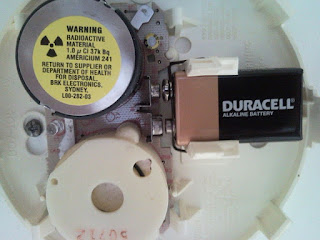Preparation of Lithium Aluminum Hydride
Introduction
When lithium hydride is treated with an ether solution of aluminum chloride under the conditions described in the experimental part of this paper, the new ether soluble compound, lithium aluminum hydride, LiAlH4, is formed according to the equation:
4 LiH + AlCl3 =======> LiAlH4 + 3 LiCl
Addition of further quantities of aluminum chloride yields an etheral solution of aluminum hydride:
3 LiAlH4 + AlCl3 =======> 4 AlH3 + 3 LiCl
The latter solution is not stable; it soon deposits a white solid in which the atomic ratio of aluminum to hydrogen still is 3:1, but from which the ether cannot be completely removed without loss of hydrogen. Lithium aluminum hydride, on the other hand, may be freed from the solvent completely by evaporation of the latter under suitable conditions. Through the use of lithium aluminum hydride, new methods, far simpler than any hitherto available, have been developed for the preparation of hydrides such as silane and stannane and of their partially alkylated derivatives. The types of reaction by which these results have been achieved are illustrated by the equations:
LiAlH4 + SiCl4 =======> LiCl + AlCl3 + SiH4
LiAlH4 + 2 (CH3)2SnCl2 =======> LiCl + AlCl3 + 2 (CH3)2SnH2
LiAlH4 + (CH3)2Zn =======> LiAl(CH3)2H2 + ZnH2
Reactions such as these usually proceed smoothly at room temperature, and in general give excellent yields of products of high purity.
In the field of organic chemistry, lithium aluminum hydride has already proved extraordinarily useful as a reducing agent. One mole of carbon dioxide is quantitatively absorbed at room temperature by an ethereal solution containing two moles of the new compound; among the products of the reaction are lithium and aluminum salts which yield formaldehyde when they are treated with acids, but the course of the reaction has not yet been completely elucidated. Aldehydes, ketones, acid chlorides and esters are reduced to alcohols, nitrites to amines, aromatic nitro compounds to azo compounds. In many cases in which the customary reducing agents require high temperatures or pressures and give poor yields, the new reagent reacts at room temperature and at an easily regulated, convenient rate, and gives almost quantitative yields. Its action is often highly specific. In the reduction of the nitrites so far studied by us, only primary amines were produced. Its usefulness is enhanced by the fact that olefinic double bonds are not attacked, except in special cases, and it is thus possible to accomplish the selective reduction of various functional groups in unsaturated compounds.
It is of interest to compare the properties of lithium aluminum hydride with those of lithium borohydride. Both compounds are white solids, stable in air at room temperature. Thermal decomposition of lithium borohydride becomes appreciable at from 250°C to 275°C, and seems to involve an intermediate reversible step in which a compound LiBH2 is formed. The decomposition of the aluminum compound becomes noticeable at a considerably lower temperature (125°C to 150°C), and leads directly to the formation of aluminum, hydrogen and lithium hydride. Both compounds are soluble in diethyl ether, but the solubility of the aluminum compound is from seven to eight times as great as that of the borohydride. The former reacts completely and extremely rapidly when dropped into water; the reaction of the latter is slower and less nearly complete (It is to be noted, however, that lithium aluminum hydride may be safely handled, even in very humid air, probably because of the formation of a protective coating of aluminum hydroxide). Similar differences are observed in the reactions of the two compounds toward alcohols. Finally, lithium borohydride is inert toward liquid ammonia and toward amines, whereas the aluminum compound reacts with both.
The chemical properties of aluminum hydride are similar to those of lithium aluminum hydride, although the instability of the ether solution of the former limits its usefulness. Attention is here called to the possibility that the unstable ether solution of the compound may afford a means of following by molecular weight determinations the course of the polymerization assumed to be responsible for the stable, insoluble solid form of the substance.
The Preparation of Lithium Aluminum Hydride.
A. Reagents.
Unless the lithium hydride is finer than 100 mesh, its reaction with aluminum chloride occurs very slowly. After weeks of refluxing 20 to 60 mesh hydride with a diethyl ether solution of aluminum chloride, only a slight surface reaction had occurred. The relatively coarse "crystalline lump" hydride, which seems to be the only form now commercially available, must be ground before use. The grinding and sifting of the material should be carried out in an atmosphere of dry nitrogen.
We have used samples of purity varying from 87 to 94% without significant differences in the results. The quantities of lithium hydride are stated in the description of the preparative procedures in terms of pure compound. The aluminum chloride was anhydrous and of reagent quality. Anhydrous diethyl ether of the usual commercial grade proved satisfactory.
B. Apparatus.
Most of the reactions were carried out in three-necked flasks fitted with a mercury-sealed stirrer, a reflux condenser, and a dropping funnel, such as are used for Grignard reactions. Usually an atmosphere of dry, carbon dioxide-free nitrogen was employed both during the reaction and in the filtrations, but these precautions were found not to be absolutely essential.
C. Procedure.
In a typical preparation, an excess of lithium hydride (23.5g or 2.96 moles) was added to a solution of 3.05g (0.08 mole) of lithium aluminum hydride in 30 ml of diethyl ether, and the mixture was stirred for a short time. After the addition of a further quantity of ether (200 ml), a solution of 71.2g (0.534 mole) of aluminum chloride in 300ml of ether was introduced at such a rate that boiling of the liquid in the reaction vessel was continuous. The mixture was stirred during this step, and for a short time after the reaction had apparently ceased The precipitated lithium chloride and the excess of lithium hydride were separated from the solution by passing the latter through a coarse sintered glass disk under nitrogen pressure.
An aliquot (6.049g) of the 462.5g of combined filtrate and washings was evaporated at atmospheric pressure until a thick sirup had formed The last of the ether was then removed in vacuo at 70°C. The resulting solid weighed 0.280g and consisted of lithium aluminum hydride of 95.4% purity according to an analysis carried out by dissolving an amount of the compound in anhydrous dioxane, and adding water drop by drop until gas evolution ceased. Lithium aluminum hydride hydrolyzes according to the following equation:
LiAlH4 + 4 H2O ===> LiOH + Al(OH)3 + 4 H2
In the resulting solution, aluminum was determined as its oxide, and lithium as the sulfate. The quantity of the compound contained in the original solution was, therefore, 20.42g, of which 3.05g had been contained in the original reaction mixture. The net yield thus was 17.37g (0.458 mole) or 85.7% of the theoretical. It has been found that allowing the reaction to stand for a longer time before filtration improves the yield and increases the purity of the product (it may become as high as 99% without recrystallization). The bulk of the reaction product was usually not taken to dryness, since most of the reactions to be investigated were carried out in ethereal solutions. For determination of the concentrations of the solutions, measurement of the amount of hydrogen evolved by hydrolysis of an aliquot is adequate.
The addition of the small amount of previously prepared lithium aluminum hydride to the reaction mixture prevents a phenomenon which otherwise may be very troublesome. Without this addition, an initial reaction usually manifests itself by a slight rise in temperature, but soon either ceases entirely or becomes too slow to be appreciable. After an induction period, which may last for only a few minutes or may persist for hours, the reaction again sets in, this time with such vigor that it can usually not be controlled by cooling of the mixture. In the presence of a small initial quantity of lithium aluminum hydride, the reaction sets in at once at a rate controlled by the rate of addition of aluminum chloride. To obtain lithium aluminum hydride for this purpose when none is available from previous preparations, two procedures are illustrated by the following examples:
1. A small quantity of aluminum chloride (2.7g) was mixed with a 6-fold excess of lithium hydride (4g) under dry nitrogen in a small round bottomed flask, which was then attached through a standard ground glass joint to a vacuum system, and evacuated. About 15 ml of ether was condensed on the reaction mixture at liquid nitrogen temperature. The reaction, which began as the flask was warmed slowly, was allowed to proceed vigorously, but was kept under control by cooling the flask with liquid nitrogen from time to time. The reaction was usually completed in about five minutes. Filtration of the resulting mixture and removal of the solvent from the filtrate as previously described yielded a sample of lithium aluminum hydride adequate for initiation of the reaction of larger batches.
2. Solid lithium hydride (7.0g) was mixed with solid anhydrous aluminum chloride (15.95g) in a 500 ml flask previously flushed with dry nitrogen. Subsequent addition of 150 ml of dioxane caused the temperature to rise to 50°C. The mixture was refluxed for one-half hour, after which it was cooled, diluted with 135 ml of diethyl ether and refluxed again for another three hours. The resulting mixture was filtered. The solid obtained from the filtrate by the procedure used in the preceding examples seemed to contain only about 30% of lithium aluminum hydride, but nevertheless served to initiate the desired reaction.
Solubility of lithium aluminum hydride
The solubility of lithium aluminum hydride in grams per 100g of various ethers at 25°C are as follows: diethyl ether 25-30, tetrahydrofuran 13, dibutyl ether 2 and dioxane 0.1. Because of the difficulty of handling the extremely viscous solutions obtained in the first two solvents, the data are of only approximate character.
Reference: J. Am. Chem. Soc. 69, 1199 (1947)
https://www.erowid.org/archive/rhodium/chemistry/lah.synthesis.html
http://lewis.armscontrolwonk.com/archive/7001/curious-case-of-red-mercury
| 








